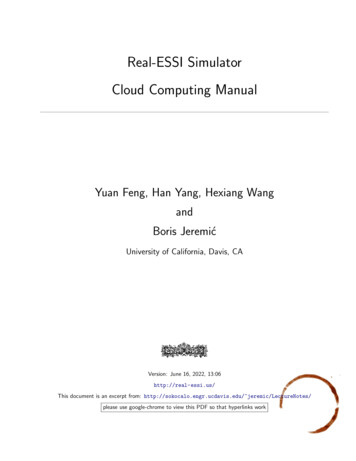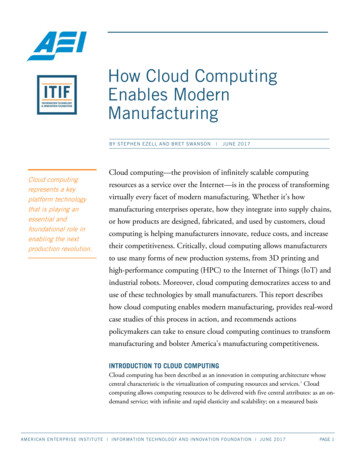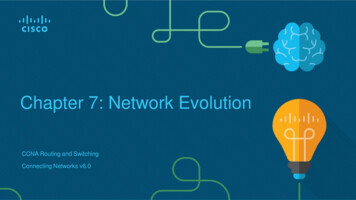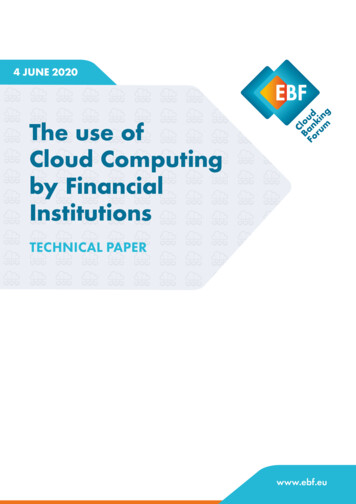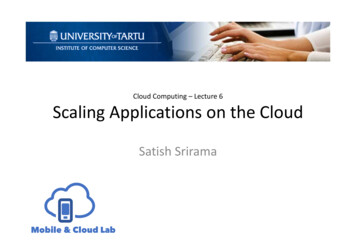
Transcription
Cloud Computing – Lecture 6Scaling Applications on the CloudSatish Srirama
Updates to course organization Coronavirus (COVID-19) Lectures will be online Changes in grading– 5% from attendance is removed– 50% from labs and 50% from examination3/17/2020Satish Srirama2/46
Outline Scaling Information Systems Scaling Enterprise Applications in the Cloud Auto Scaling– Amazon Auto Scale and Elastic Load Balancing– Open source options for developing Auto Scalesolutions3/17/2020Satish Srirama3/46
Scaling Information Systems Fault tolerance, high availability & scalability areessential prerequisites for any enterpriseapplication deployment Scalability– Generally nodes in information systems supportspecific load– When load increases beyond certain level, systemsshould be scaled up– Similarly when load decreases they should be scaleddown3/17/2020Satish Srirama4/46
Typical Web-based EnterpriseApplicationSource: http://en.wikipedia.org/wiki/File:LAMPP Architecture.png3/17/2020Satish Srirama5/46
Typical Load on an Application Server[ClarkNet traces]3/17/2020Satish Srirama6/46
Scaling Information Systems continued Two basic models of scaling– Vertical scaling Also known as Scale-up– Horizontal scaling Aka Scale-out3/17/2020Satish Srirama7/46
Vertical Scaling Achieving better performance by replacing anexisting node with a much powerful machine Risk of losing currently running jobs– Can frustrate customers as the service istemporarily down3/17/2020
Horizontal ScalingArrival rate [req/sec] Num. of servers Achieving better performance by adding morenodes to the system New servers are introduced to the system torun along with the existing servers22201816141210864Optimal policyAuto ScaleAlways 02468101214Time [hours]Server allocation policies for different loads3/17/202014Satish Srirama[Vasar et al, Nordicloud 2012]9/46
Scaling Enterprise Applications in theCloudClient SiteClient SiteClient SiteLoad Balancer h SriramaAppServerAppServerMemcache10/46
Load Balancer Load balancing has been a key mechanism inmaking efficient web server farms Load balancer automatically distributes incomingapplication traffic across multiple servers Hides the complexity for content providers 1 1 2– Allows server farms work as a single virtual powerfulmachine 1 1 2– Beyond load distribution, improves response time3/17/2020Satish Srirama11/46
Introduction- Types of Load Balancers Network-Based load balancing– Provided by IP routers and DNS (domain name servers) that service a pool ofhost machines– e.g. when a client resolves a hostname, the DNS can assign a different IPaddress to each request dynamically based on current load conditions Network-Layer based load balancing– Balances the traffic based on the source IP address and/or port of theincoming IP packet– Does not take into account the contents of the packet, so is not very flexible Transport-Layer based load balancing– The load balancer may choose to route the entire connection to a particularserver– Useful if the connections are short-lived and are established frequently Application-Layer/Middleware based load balancing– Load balancing is performed in the application-layer, often on a per-session orper-request basis3/17/2020Satish Srirama12/46
Introduction- Classes of LoadBalancers Non-adaptive load balancer– A load balancer can use non-adaptive policies, such assimple round-robin algorithm, hash-based orrandomization algorithm Adaptive load balancer– A load balancer can use adaptive policies that utilizerun-time information, such as amount of CPU load onthe node Load Balancers and Load Distributors are not thesame thing– Strictly speaking non-adaptive load balancers are loaddistributors3/17/2020Satish Srirama13/46
Load Balancing Algorithms Random– Randomly distributes load across the available servers– Picks one via random number generation and sending thecurrent connection to it Round Robin– Round Robin passes each new connection request to the nextserver in line– Eventually distributes connections evenly across the array ofmachines being load balanced Least connection (Join-Shortest-Queue)– The system passes a new connection to the server that has theleast number of current connections wSBpc4a5SM3/17/2020Satish Srirama14/46
Examples of Load Balancers Nginx - http://nginx.org/ HAProxy - http://haproxy.1wt.eu/ Pen - http://siag.nu/pen/etc.3/17/2020Satish Srirama15/46
Testing the System by Simulating Load Benchmarking tools– Tsung, JMeter, etc Simulating concurrency is also possible Multiple protocols– HTTP, XMPP, etc.– SSL support3/17/2020Satish Srirama16/46
Scaling in the Cloud - bottleneckClient SiteClient SiteClient SiteLoad Balancer erAppServerDatabasebecomestheMemcacheDBScalability BottleneckCannot leverage elasticity
Scaling in the Cloud - bottleneckClient SiteClient SiteClient SiteLoad Balancer erScalable and Elastic,MemcacheDB StoresKeyValuebut limited consistency andoperational flexibility NoSQL3/17/2020Distributed Data Processing on theCloud - LTAT.06.005 (Fall 2018)
Horizontal Scaling – Further examples MapReduce & Hadoop– We will look as part of next lectures3/17/2020Satish Srirama19/46
AutoScaleArrival rate [req/sec]– High availability– Cost saving– Energy savingNum. of servers AutoScale allows systems to dynamically reactto a set of defined metrics and to scaleresources accordingly Providing:22201816141210864Optimal policyAuto ScaleAlways 0002468101214Time [hours]Server allocation policies for different loads3/17/2020Satish Srirama20/46
Typical Usecases Applications that see elasticity in theirdemand Launching a new website with unknownvisitor numbers Viral marketing campaigns A scientific application might also have toscale out– Using 50 machines for 1 hour rather than 1machine for 50 hours3/17/2020Satish Srirama21/46
Types of Traffic Patterns ON & OFF– Analytics!– Banks/Tax Agencies!– Test environments FAST GROWTH– Events!– Business Growth! VARIABLE– News & Media!– Event Registrations!– Rapid fire sales CONSISTENT– HR Application!– nuk/autoscaling-best-practices3/17/2020Satish Srirama22/46
Auto-Scaling enterprise applicationson the cloud Enterprise applications are mostly based on SOA andcomponentized models Auto-Scaling– Scaling policy - When to Scale– Resource provisioning policy - How to scale Threshold-based scaling policies are very popular dueto their simplicity– Observe metrics such as CPU usage, disk I/O, networktraffic etc.– E.g. Amazon AutoScale, RightScale etc.– However, configuring them optimally is not easySOA - Service-oriented architecture3/17/2020Satish Srirama23/46
AutoScaling on the cloud Amazon Autoscale & Elastic Load Balance Vendor neutral autoscaling on cloud– Static Load Balancer Resources estimation onthe fly (e.g optimal heuristics) [Vasar et al, Nordicloud 2012]– Static Load Balancer Optimal resourceprovisioning [Srirama and Ostovar, CloudCom 2014]3/17/2020Satish Srirama24/46
Amazon Auto Scaling Amazon Auto Scaling allows you to scale your computeresources dynamically and predictably (scaling plan):– Dynamically based on conditions specified by you E.g. increased CPU utilization of your Amazon EC2 instance– CPU utilization of all servers on average is 75% in last 5 min, add 2 serversand average 35% remove 1 server– Predictably according to a schedule defined by you E.g. every Friday at 13:00:00. EC2 instances are categorized into Auto Scaling groups forthe purposes of instance scaling and management You create Auto Scaling groups by defining the minimum &maximum no of instances A launch configuration template is used by the Auto Scalinggroup to launch Amazon EC2 instances3/17/2020Satish Srirama25/46
Amazon Auto Scaling - continued Auto Scaling– Monitor the load on EC2instances usingCloudWatch– Define Conditions andraise alarms E.g. Average CPU usageof the Amazon EC2instances, or incomingnetwork traffic frommany different AmazonEC2 instances– Spawn new instanceswhen there is too muchload or remove instanceswhen not enough load3/17/2020Satish Srirama26/46
Amazon CloudWatch Monitor AWS resources automatically– Monitoring for Amazon EC2 instances: seven pre-selected metrics at fiveminute frequency– Amazon EBS volumes: eight pre-selected metrics at five-minute frequency– Elastic Load Balancers: four pre-selected metrics at one-minute frequency– Amazon RDS DB instances: thirteen pre-selected metrics at one-minutefrequency– Amazon SQS queues: seven pre-selected metrics at five-minute frequency– Amazon SNS topics: four pre-selected metrics at five-minute frequency Custom Metrics generation and monitoring Set alarms on any of the metrics to receive notifications or take otherautomated actions Use Auto Scaling to add or remove EC2 instances dynamically based onCloudWatch metrics3/17/2020Satish Srirama27/46
Elastic Load Balance Elastic Load Balance– Automatically distributes incoming applicationtraffic across multiple EC2 instances– Detects EC2 instance health and diverts trafficfrom bad ones– Support different protocols HTTP, HTTPS, TCP, SSL, or Custom Amazon Auto Scaling & Elastic Load Balancecan work together3/17/2020Satish Srirama28/46
Components of an Auto Scaling system Load balancer Solutions to measure the performance ofcurrent setup Scaling policy defining when to scale Resource provisioning policy Dynamic deployment template3/17/2020Satish Srirama29/46
Cloud-based Performance – Opensolutions Multiple approaches are possible Shell– Linux utilities Default– free –m– cat /proc/cpuinfo /prof/meminfo– df –h Sysstat package (iostat, sar)3/17/2020Satish Srirama30/46
Cloud-based Performance - continued Tools (distributed)– Collectd RRDtool– Generating visual performance graphs Multicast communication Does not impact system performance– Cacti RRD GUI Performance decreases by 20%RRDtool - round-robin database tool3/17/2020Satish Srirama31/46
Cloud-based Performance - continued Cacti– Spikes denote gathering performance metrics Other tools: Grafana3/17/2020Satish Srirama32/46
Scaling Policy Time based– Already seen with Amazon Auto Scale E.g. every Friday at 13:00:00 or Feb 15th 10 more servers for Estoniantax board– Good for On & Off! and Consistent traffic patterns Reactive– Threshold-based scaling policies E.g. CPU utilization of all servers on average is 75% in last 5 min– Good for Fast Growth traffic pattern Predictive– AutoScaling based on predictive traffic E.g. Predicting next min load by taking mean of last 5 min load– Good for Variable traffic pattern3/17/2020Satish Srirama33/46
Components of an Auto Scaling system Load balancer Solutions to measure the performance ofcurrent setup Scaling policy defining when to scale Resource provisioning policy Dynamic deployment template3/17/2020Satish Srirama34/46
Resource provisioning policy Simple resource provisioning policy– Resources estimation based on heuristic– E.g. suppose a node supports 10 rps and currentsetup has 4 servers and load is 38 rps Assume load increased or predicted to increase to 55rps So add 2 more servers May not be optimal or perfect solution, butsufficient for the immediate goals3/17/2020Satish Srirama35/46
Optimal Resource Provisioning forAuto-Scaling Enterprise Applications Cloud providers offer various instance types withdifferent processing power and price– Can it be exploited in deciding the resourceprovisioning policy?– Makes the policy to be aware of current deploymentconfiguration Another challenge: Cloud providers charge theresource usage for fixed time periods– E.g. Hourly prices of Amazon cloud Developed an LP based optimization model whichconsiders both the issues [Srirama and Ostovar, CloudCom 2014]3/17/2020Satish Srirama36/46
Scaling enterprise application with theoptimization modelIncoming load and scalingcurves of Optimization modelInstance type usage curves ofOptimization modelScaling with AmazonAutoScale[Srirama and Ostovar, CloudCom 2014]3/17/2020Satish Srirama37/46
Optimization ModelIntuition behind instance lifetime consideration Consider 2 instance types– Small instance(PW 6r/s, Price 0.25/h),– Medium instance(PW 12r/s, Price 0.4/h)Load is 6r/sLoad increases to 12r/s ?Solution 1Cost (cost of two small instances) - (10-min profit of a small instance) 0.5 - 0.04 0.46Solution 2Cost (cost of a medium instance) (10-min cost of a small instance) 0.4 0.04 0.44 Saved cost with solution 2 : 0.46 – 0.44 0.02 So can we find this automatically?3/17/2020Satish Srirama38/46
Optimization ModelSome key definitions Region:– A task with its own independent characteristics– Each region can have its own capacity of instances Instance Type:– Each region can include multiple instance types– It is associated with processing power, price per period, capacityconstraint, and configuration time Time bags:– Time interval where an instance is at a particular time Killing Cost:– Money lost when an instance is killed before it fills its paid period Retaining Cost:– The cost of the lived duration of the paid period[Srirama and Ostovar, CloudCom 2014]3/17/2020Satish Srirama39/46
Optimization ModelCost of new instances Configuration cost ofnew instancesCost Function:Cost of killed instancesCost of retained instances Constraints:Workload constraintCloud capacity constraintInstance type capacity constraintShutdownconstraint3/17/2020Satish Srirama[Srirama and Ostovar, CloudCom 2014] 40/46
Application of the model Identify the scalable components in an enterpriseapplication Scalable components are load tested on theplanned cloud– To extract application specific parameters of themodel Incoming load of each region is extracted and fedto the optimization model– Produces the ideal deployment configuration of theapplication3/17/2020Satish Srirama41/46
Evaluation of the optimization model The optimization model performs at least as good asAmazon AutoScale– Sometimes outperforms in efficiency and mostly inresponse times– Further optimizations with scaling policy can also save cost The model is generic and can be applied to any cloud– Which follows similar utility computing model It is also applicable to the systems which need to spanacross multiple clouds The latencies are also reasonable– The model could always find the optimal solution withindecent amount of time[Srirama and Ostovar, CloudCom 2014]3/17/2020Satish Srirama42/46
Components of an Auto Scaling system Load balancer Solutions to measure the performance ofcurrent setup Scaling policy defining when to scale Resource provisioning policy Dynamic deployment template3/17/2020Satish Srirama43/46
Dynamic deployment template Standard compliant dynamic deployment ofapplications across multiple clouds Topology & Orchestration Specification of CloudApplication Goal: cross cloud, cross tools orchestration ofapplications on the Cloud Node Type Relationship TypeLater lecture TOSCA Template3/17/2020Satish Srirama44/46
CloudML Developed in REMICS EU FP7 project Developed to tame cloud heterogeneity Domain-specific language (DSL) for modellingthe provisioning and deployment at designtime– Nodes, artefacts and bindings can be defined Different means to manipulate CloudMLmodels– Programmatically via Java API– Declaratively, via serialized model (JSON) Models@Runtime– Dynamic deployment of CloudML based models3/17/2020Satish Srirama[Ferry et al, Cloud 2013]45/46
TOSCA Topology & Orchestration Specification of CloudApplication By OASIS– Sponsored by IBM, CA, Rackspace, RedHat, Huaweiand Others Goal: cross cloud, cross tools orchestration ofapplications on the Cloud Node Type Relationship Type TOSCA y.html3/17/2020Satish Srirama46/46
Final Thoughts on AutoScaling AutoScaling can be dangerous– E.g. Distributed Denial of Service (DDoS) attack– Have min-max allocations Choose the right metrics– Stay with basic metrics CPU, mem, I/O disk/net etc.– Review autoscaling strategy with metrics Choose your strategy– Scale up early and Scale down slowly– Don’t apply the same strategy to all apps3/17/2020Satish Srirama47/46
This week in lab You work with load balancing3/17/2020Satish Srirama48/46
Next Lecture Data analytics on the cloud3/17/2020Satish Srirama49/46
References Amazon Web (Cloud) Services – documentation http://aws.amazon.com/documentation/Elastic Load balancing http://aws.amazon.com/elasticloadbalancing/Load balancing - algorithms pc4a5SM Auto Scaling - Amazon Web Services http://aws.amazon.com/autoscaling/Cluet, M., Autoscaling Best Practices, st-practicesM. Vasar, S. N. Srirama, M. Dumas: Framework for Monitoring and Testing Web ApplicationScalability on the Cloud, Nordic Symposium on Cloud Computing & Internet Technologies(NORDICLOUD 2012), August 20-24, 2012, pp. 53-60. ACM.S. N. Srirama, A. Ostovar: Optimal Resource Provisioning for Scaling Enterprise Applicationson the Cloud, The 6th IEEE International Conference on Cloud Computing Technology andScience (CloudCom-2014), December 15-18, 2014, pp. 262-271. IEEE.S. N. Srirama, T. Iurii, J. Viil: Dynamic Deployment and Auto-scaling Enterprise Applications onthe Heterogeneous Cloud, 9th IEEE International Conference on Cloud Computing (CLOUD2016), June 27- July 2, 2016, pp. 927-932. IEEE.S. N. Srirama, A. Ostovar: Optimal Cloud Resource Provisioning for Auto-scaling EnterpriseApplications, International Journal of Cloud Computing, ISSN: 2043-9997, 7(2):129-162, 2018.Inderscience.3/17/2020Satish Srirama50/46
Non-adaptive load balancer - A load balancer can use non-adaptive policies, such as simple round-robin algorithm, hash-based or randomization algorithm Adaptive load balancer - A load balancer can use adaptive policies that utilize run-time information, such as amount of CPU load on the node Load Balancers and Load Distributors .






